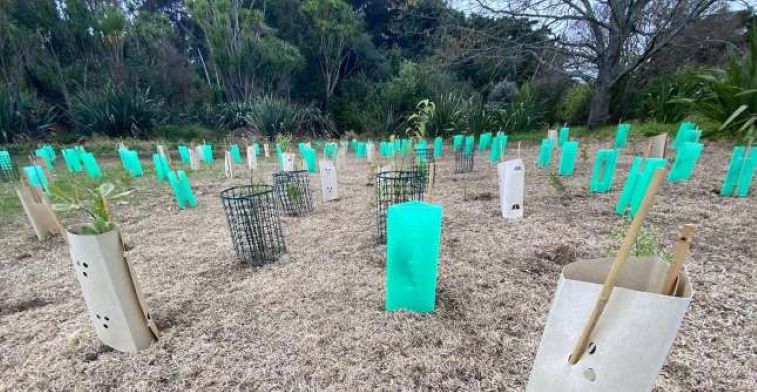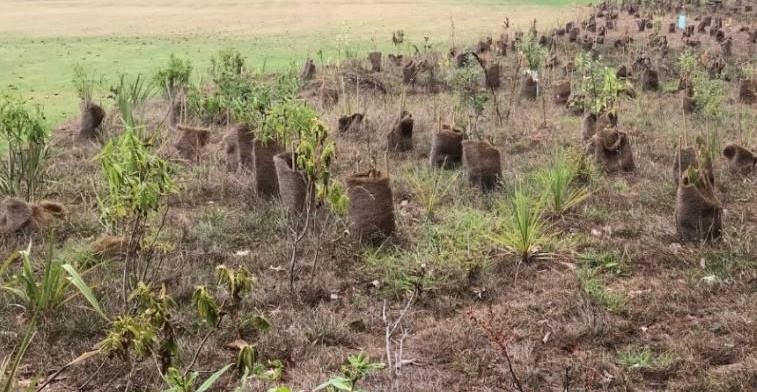Plant guards
Plant guards can help establish seedlings. They can protect young plants from weather damage, animals, herbicides, weeds and other physical damage. You may choose to use plant guards to protect your trees as they grow.
Plant guards offer reassurance your plants will grow better. This is useful when:
- the plants are expensive
- you don’t have much experience with planting
- the plants could be damaged, for example by brush cutting or from weed spray
- the plants are vulnerable to weeds
- there’s a risk of damage from animals.
Plant guards can be expensive. You do not generally need them if you have good quality seedlings, prepare the site well, weed regularly and protect plants from grazing animals.
You may not need plant guards for all your trees.
Choosing the right plant guard
Different guards are useful for different sites, management plans and plants.
When choosing a guard, think about:
- the reason for using a guard
- how long you need to use them for
- cost including the guard, installation, maintenance and removal
- what else you might use instead of guards.
Plant characteristics and plant guards
Which plant guard you choose depends on your plant's characteristics, including:
- height
- shape
- if animals will eat the plants
- vulnerability to fungal diseases
- vulnerability to competition
- type of competition
- vulnerability to damage.
Here are some examples of how your tree influences your guard choice.
Appetising to animals
If animals are likely to eat your tree, your guard needs to be tall enough to stop them from browsing. Instead of a plant guard, you could manage pest animals before planting, or use plants that animals are less likely to eat.
Vulnerable to disease
If your plant is vulnerable to fungal disease, a plant guard may increase the humidity and temperature inside the guard. This makes the plant more likely to get fungal diseases.
Types of plant guard
Here are some common plant guards and things to think about when using them.
Netting (plastic or wire)
- protects from browsing animals (including stock) and physical damage.
- is cheap to make yourself from firm netting
- is robust in high winds
- is long lasting.
What to consider:
- the netting height needs to be taller than the size of any browsing animals
- does not protect from herbicides or weeds
- does not improve growing conditions, for example by protecting the trees from frost
- will need to be removed to avoid ring barking as the stem grows. Ring barking is when bark is removed from the trunk.
Rigid plastic
- protects from herbicides, wind and frost
- extends the growing season, allowing you to plant later in the season
- some types are reusable
- is long lasting.
What to consider:
- you’ll need to remove it from the site
- triangular shapes are more wind resistant than square
- can contribute to microplastics in the environment
- not recommended for riparian planting if the plants are likely to flood. This is because the guards can end up in waterways.
Flexible plastic
- protects from herbicides and frost
- extends growing season
- can be cheap
- can be stapled together to make wider or higher
- can be supported by fencing wire hoops which are cheaper than buying stakes.
What to consider:
- does not last very long
- traditional plastic can break down into the soil and pollute it
- you’ll need to remove it from the site
- not as good at protecting from wind.
Cardboard
- protects from herbicide, frost and wind
- is biodegradable, so can be left on the site as mulch.
What to consider:
- may not last long, especially in wet weather, depending on the weight and surface treatment of cardboard
- can collapse into plants
- can create a dark growing environment.
Wool felt or coir
- protects from herbicide and frost
- may protect from wind if properly staked
- is biodegradable, so can be left on the site as mulch.
What to consider:
- may not last long, especially on wet sites, depending on the weight and surface treatment
- may collapse depending on site conditions and how the guards are set up. Collapsed guards do not provide benefits and can smother the plant and kill it.
Tree trunk wraps or tubes
- protects from browsing animals and other damage (such as weed eaters)
- long-lasting, especially if they’re expandable
- can be placed to keep loose organic mulch away from the trunk. This helps protect plant stems from rot.
What to consider:
- non-expandable covers need timely removal or can damage tree trunks
- can reduce damage from herbicide if tall enough
- do not provide weed control.
Stakes
Some guards need stakes to hold them in place. When the amount of stakes you need is optional, choose the number and type of stakes based on how long you want the guard to last, how windy the site is.
When choosing stakes, compare the prices. For example bamboo poles are cheaper compared to treated timber stakes.
If you need timber stakes to last more than 18 to 24 months, get treated timber. Natural timber will rot in the ground within a year or 2 and the guard will fall over.
You can make hoops from materials on site, like fencing wire and use these instead of stakes.
Examples of plant guards



Plant guard purposes
Knowing the purpose of your plant guard helps you choose the best type. Here are some plant guard purposes, and other things you can do to protect your trees.
Stop browsing animals
The plant guard should be the size of the browsing animal. About 120cm for sheep, 75cm for hares and possums, 60cm for rabbits. If you have browsing animals bigger than this, you may need to fence the site too. It's also important to choose the correct size, height and guard option for the species you're planting.
The guard should not expose the roots or lower stem of the plant. This is because animals may eat these parts of the plant.
If you're using plant guards to help with pest animal control, you'll probably need to use a combination of pest control methods to be effective.
Other options:
- fence the area
- pre-planting and post-planting pest control
- use forest slash/branches or tall grass to protect the plants
- use animal repellent
- planting species like totara, kānuka, tutu, that are less desirable to animals.
Protect plants from herbicide
The guard should be able to block herbicide spray if you’re using it to release plants from weeds. The guard should also be strong enough to stop shoots from growing through the sides.
Other options:
- use mulches to prevent weeds along with pre-planting weed control
- choose species that allow selective herbicides for the main weeds. Selective herbicides target specific plants
- release plants by hand instead of spraying herbicide.
Protect plants from physical damage
The guard must be strong enough to resist line-trimmers and brush-cutters. If the guard helps you see where the plant is, it’ll help avoid damage.
Other options:
- use physical obstacles like rock piles or tree branches to protect the plants
- weed by hand close to the plant stem, so trimmers do not go near the plants
- use just the stakes to show you where the plants are
- consider adding flagging tape or paint with different colours to show the year of planting for multi year projects
- use mulching instead of line trimmers.
Protect from wind
On windy sites, narrow or triangular guards are more resilient than square guards. Rigid sides are best, with enough stakes to hold the guard in the ground and away from the plant. Mesh guards let the wind blow through, helping you avoid lost or damaged guards.
Other options:
- pre-plant shelter belts 1-4 years before planting. Shelter belts are strips of plants that create a wind barrier. They reduce damage to a distance of up to 10 times their height. Shelter belts can be flax, shrubs or trees
- create wind-rows with forestry slash (leftover branches and logs from cut down trees)
- use straw bales or tie wind-cloth to a nearby fence.
Protect from weeds
- guards need to be taller than the weeds
- if using weed mats with your guards, the mats should be wide enough to stop weeds growing close to the plant
- weed mats should nearly touch the plant stem to make sure weeds don’t grow up through the guard, competing for light and nutrients. Check that rough guards don’t rub against the plant stem as this can cause damage, including ringbarking
- weed mats, coir, wool and felt materials help to save soil moisture by stopping weeds from growing under them.
Other options:
- remove weeds before planting
- blanket mulch
- weed control after planting.
Protect from frost
Use guards that create a greenhouse effect and a sheltered micro-climate. The sides of the guard should reach the ground. Clear materials may be best.
Other options:
- expose seedlings to different weather conditions before planting outside. This prepares them for the outdoors and is called hardening off
- choose species that can handle frost
- keep cover across the site
- remove barriers to frost flow
- cultivate the soil to raise the area where you're planting seedlings (for example rip and bed or spot-mound)
- use branches or logs to create protected micro-sites.
About this page
This content was produced in collaboration with Manaaki Whenua – Landcare Research. It is part of the technical report: Improving resilience of native New Zealand woody seedlings to drought, commissioned by One Billion Trees, Te Uru Rākau – New Zealand Forest Service.